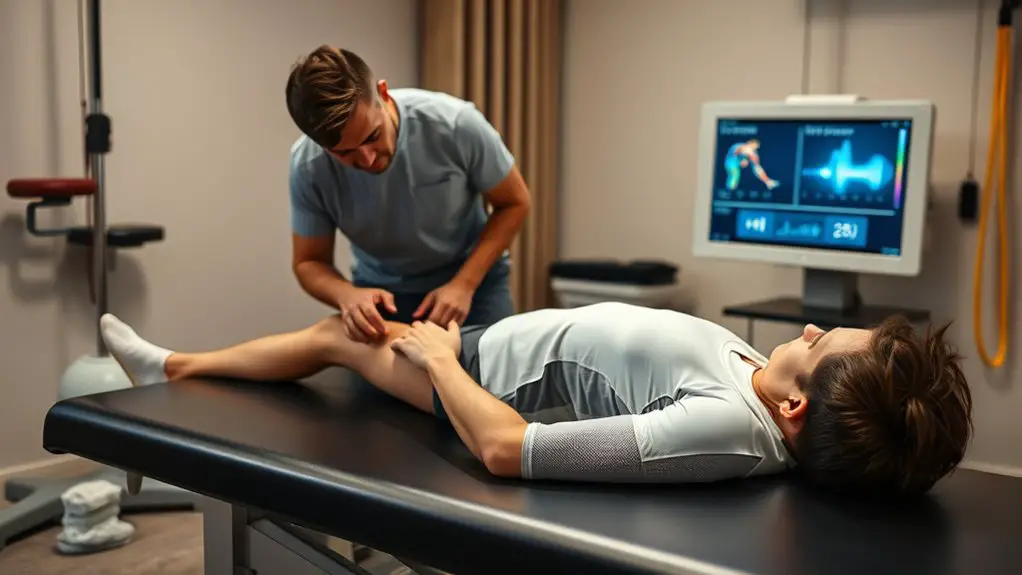How Athletes Recover From Injuries and Return to Peak Form

Recovering from injuries is a complex journey, but with the right strategies, you can regain your peak form. Start by working closely with medical professionals who assess your injury and tailor a rehabilitation program. Incorporate innovation in treatment, such as regenerative medicine, while ensuring proper nutrition to support healing. Balance your recovery with cross-training to maintain overall fitness. Setting realistic goals helps track progress and fosters motivation. To discover more strategies for effective recovery, continue exploring how to support your journey.
Understanding the Mechanisms of Sports Injuries

When you step onto the field, you might not think about the intricate mechanisms behind sports injuries, yet understanding them can greatly impact your recovery. Various injury types can stem from overuse, acute trauma, or biomechanical issues. A biomechanics analysis helps identify movement patterns that may lead to injury, guiding effective injury prevention strategies.
During the healing process, pain management becomes vital as you navigate the recovery phases. Knowing how tissue regeneration occurs can empower you to participate in rehabilitation techniques that promote healing. Each phase of recovery is essential, from initial rest to gradual reintroduction of activity.
The Role of Medical Professionals in Recovery
While you focus on your recovery journey, the expertise of medical professionals plays an essential role in guiding you through each stage. Their ability to conduct thorough injury assessments is critical; they identify the extent of your injury and tailor the recovery process accordingly. With their knowledge of various rehabilitation techniques, they help you regain strength and mobility effectively.
These professionals not only provide physical therapy but also offer psychological support, understanding the mental challenges that accompany your recovery. They monitor your progress closely, adjusting your rehabilitation plan as necessary to guarantee you’re on track.
Tailored Rehabilitation Programs

Tailored rehabilitation programs are essential for your recovery, as they address your specific injury and individual needs. These programs begin with personalized assessments, where professionals evaluate your physical condition, injury severity, and functional limitations. This tailored approach guarantees that the rehabilitation plan is not only effective but also aligns with your athletic goals.
Incorporating injury specific exercises, these programs focus on strengthening the affected area while promoting overall mobility and stability. By gradually increasing the intensity of these exercises, you’ll rebuild confidence and strength without risking further injury.
Moreover, these programs are adaptable, allowing for modifications based on your progress. Regular check-ins and feedback loops help your rehabilitation team refine your program, making sure it remains aligned with your evolving needs. Ultimately, a tailored approach not only facilitates recovery but also prepares you to return to peak form, ready to excel in your sport.
Innovations in Injury Treatment
As rehabilitation programs evolve, so do the techniques and technologies used in injury treatment. Regenerative medicine, for instance, is transforming how you heal, utilizing your body’s own cells to accelerate recovery. Techniques like platelet-rich plasma therapy facilitate faster healing, making a significant impact on your return to peak form.
Additionally, cryotherapy techniques are gaining traction, offering pain relief and reduced inflammation through extreme cold exposure. This can be especially beneficial after intense training or competition.
Wearable technology also plays an essential role, providing real-time data on your recovery progress. By monitoring important metrics, you can better understand your body’s needs and adjust your rehabilitation accordingly.
Finally, virtual rehabilitation platforms allow you to engage in guided therapy sessions remotely, making it easier to stay consistent with your recovery plan. These innovations not only enhance your healing process but also empower you to take an active role in your recovery journey.
The Importance of Nutrition in Healing

Nutrition plays an essential role in the healing process, influencing not only recovery speed but also the overall effectiveness of rehabilitation efforts. As an athlete, you need to focus on nutrient timing—consuming the right nutrients at the right moments can greatly enhance your recovery. For example, post-workout protein intake is vital for muscle repair, while carbohydrates can help replenish glycogen stores.
Additionally, don’t underestimate the importance of hydration strategies. Staying properly hydrated supports cellular function, reduces inflammation, and helps transport nutrients throughout your body. Dehydration can slow down the healing process, so make sure you’re drinking enough fluids, especially during recovery workouts.
Incorporating a balanced diet rich in vitamins and minerals will also provide your body with the tools it needs to heal effectively. By prioritizing nutrition, you’re not just fueling your recovery; you’re setting yourself up for a successful return to peak performance.
Mental Resilience and Psychological Support
Injury recovery isn’t just about physical healing; mental toughness plays a critical role in your journey back to peak performance. Psychological coaching can provide you with the tools to navigate the emotional challenges you face, helping you build resilience. By addressing both your mental and physical needs, you can create a more holistic approach to recovery.
Importance of Mental Toughness
Mental resilience stands as a cornerstone in the journey of recovery from athletic injuries, shaping not only the healing process but also your overall outlook. It’s essential to understand that overcoming physical setbacks isn’t just about physical rehabilitation; it’s deeply intertwined with your mental state. Implementing psychological strategies, such as visualization and positive self-talk, can greatly bolster your mental resilience. These techniques help you navigate the emotional ups and downs of recovery, keeping you focused on your goals. By cultivating mental toughness, you can transform challenges into opportunities for growth. Remember, your mindset plays a vital role in not just healing but also in returning to peak performance, making psychological support an invaluable part of your recovery journey.
Role of Psychological Coaching
While the physical aspects of recovery are essential, the role of psychological coaching cannot be overstated. Psychological strategies help you build mental resilience, allowing you to cope with setbacks and maintain motivation. Emotional support from coaches and peers can greatly impact your recovery journey, fostering a sense of belonging and encouragement.
| Psychological Strategies | Benefits | Emotional Support |
|---|---|---|
| Goal Setting | Increases focus | Builds confidence |
| Visualization | Enhances performance | Reduces anxiety |
| Positive Self-Talk | Boosts motivation | Strengthens connections |
| Mindfulness Practices | Improves mental clarity | Promotes emotional healing |
The Impact of Rest and Recovery Techniques

When you’re recovering from an injury, the significance of adequate rest can’t be overstated. Incorporating active recovery methods and paying attention to your nutrition can greatly enhance your healing process. Understanding how these elements work together will empower you to make informed choices that promote a faster return to your sport.
Importance of Adequate Rest
Adequate rest is fundamental for athletes, as it directly influences both physical recovery and overall performance. Without proper rest, your body struggles to heal, which can prolong injuries and hinder progress. Sleep quality plays a significant role in this process; restorative sleep helps repair muscles, replenish energy, and regulate hormones essential for recovery. Additionally, incorporating techniques like active recovery can further enhance your rest periods. Engaging in low-intensity activities allows your body to recuperate while still promoting blood flow and reducing stiffness. Prioritizing both sleep and active recovery is critical to guarantee you return to peak form. By recognizing the importance of adequate rest, you’ll set the foundation for a successful recovery and improved athletic performance.
Active Recovery Methods
Resting your body doesn’t mean being completely inactive; active recovery methods can play a significant role in your rehabilitation process. Incorporating low-impact exercises like swimming or cycling helps maintain fitness while easing strain on injuries. Active stretching and mobility drills enhance flexibility, while foam rolling and self-myofascial release can relieve muscle tension. Dynamic warm-ups prepare your body for movement and prevent stiffness. Breath work promotes relaxation and mental clarity, essential for recovery. Techniques such as contrast baths and hydrotherapy can reduce inflammation and improve circulation. Additionally, yoga practices blend physical movement with mindfulness, fostering both physical and emotional healing. Embracing these methods not only supports your recovery but also aids in your return to peak form.
Role of Nutrition
While you may focus on physical rehabilitation techniques, the role of nutrition in your recovery journey is equally essential. Proper nutrition supports healing and helps you return to peak form. Here are key aspects to contemplate:
- Nutrient Timing: Consuming proteins and carbohydrates post-workout enhances recovery.
- Hydration Strategies: Staying well-hydrated aids in muscle repair and reduces soreness.
- Anti-inflammatory Foods: Incorporating these can help mitigate inflammation, promoting quicker recovery.
Focus on meal planning and frequency to maintain a balanced intake of macronutrients and micronutrients. Recovery smoothies can be an effective way to boost protein intake and guarantee micronutrient balance. Always evaluate supplement efficacy according to dietary guidelines, as they can support your recovery process considerably. Embrace nutrition as a cornerstone of your healing journey.
Cross-Training and Maintaining Fitness During Recovery

As you navigate the recovery process after an injury, incorporating cross-training can be a strategic way to maintain your fitness levels without exacerbating your condition. Cross-training benefits include reduced risk of overuse injuries and improved overall strength, flexibility, and endurance. By engaging in low-impact activities like swimming, cycling, or yoga, you can keep your body active while allowing your injured area to heal. Additionally, utilizing low impact alternatives such as exercise bands can provide a full-body workout while minimizing stress on your joints.
These alternatives not only help in fitness maintenance but also provide a mental boost, keeping your spirits high during recovery. It’s crucial to listen to your body and consult with your healthcare provider to verify your chosen activities are safe. This balanced approach can aid in preserving your cardiovascular health and muscle tone, setting the stage for a smoother return to your primary sport. Ultimately, cross-training serves as an essential component of your recovery strategy, helping you stay fit and focused on your long-term goals.
Setting Realistic Goals and Timelines
Setting realistic goals and timelines is essential for maintaining motivation and ensuring a successful recovery from injury. By employing effective goal setting strategies and practicing timeline management, you can create a structured plan that aids in your recovery journey. Here are three key aspects to contemplate:
- Assess Your Current Status: Understand the extent of your injury, and consult with healthcare professionals for accurate insights.
- Break Down Goals: Set short-term, achievable milestones that lead to your long-term recovery objectives, keeping your focus sharp and progress steady.
- Adjust as Needed: Stay flexible and be prepared to modify your goals based on your recovery pace and any setbacks you may encounter.
The Support System: Coaches, Family, and Peers

Achieving your recovery goals isn’t just about individual effort; it’s greatly influenced by the support system around you. Coaches play a vital role in guiding your rehabilitation, offering tailored training regimens that accommodate your injury while keeping motivation high. Their experience and knowledge can help bridge the gap between your current state and peak performance.
Family members provide emotional support, reminding you that you’re not alone in this journey. Their understanding and encouragement can be invaluable, especially during tough days when progress seems slow.
Moreover, the camaraderie among teammates fosters a unique environment that can aid recovery. Sharing experiences and challenges with peers who understand the demands of athletics creates a sense of belonging. This athlete camaraderie not only boosts morale but also reinforces your commitment, making the road to recovery less isolating. Together, these elements form an extensive support system that’s essential for your successful return to the sport.
Frequently Asked Questions
How Long Does the Average Recovery Process Take for Athletes?
Think of recovery timelines like a road trip; they vary based on injury types. Generally, athletes can expect anywhere from weeks to months for recovery, depending on severity and personal factors influencing healing. Patience is key.
What Common Mistakes Do Athletes Make During Recovery?
During recovery, you might overlook overtraining signs or make nutrition errors, thinking pushing harder or skimping on meals will expedite healing. It’s essential to listen to your body and prioritize balanced nutrition for ideal recovery.
How Can Athletes Prevent Re-Injury After Recovery?
To prevent re-injury after recovery, you should focus on effective rehabilitation techniques and consistent injury prevention strategies. Gradually increasing activity levels while listening to your body can greatly reduce the risk of setbacks.
What Role Do Mental Health Professionals Play in Recovery?
Mental health professionals provide essential emotional support, fostering mental resilience during recovery. They help you navigate the psychological challenges, ensuring you’re equipped to handle setbacks and maintain a positive mindset throughout your healing process.
How Important Is Sleep for an Athlete’s Recovery?
Sleep’s significance for success can’t be overstated; your sleep cycles dictate recovery rituals. Prioritizing restorative rest not only rejuvenates your body but also sharpens your mind, ultimately propelling you back to peak performance.





